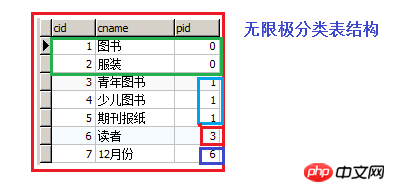
A: First, let’s look at a simple interview question
Fibonacci Sequence
Rule: 1 1 Starting from the third item, each item is the sum of the previous two items
There are two ways to implement it
The first way:
TestSelf((n<0 IllegalArgumentException("n不能为负数" (n<=2 1 TestSelf(n-2)+TestSelf(n-1 30
The second way: using array
public int TestSelfTwo(int n){ if(n<0){ throw new IllegalArgumentException("n不能为负数");
}else if(n<=1){ //递归前两个数 不管n是多少 为一 return 1;
} int[] nums = new int[n+1]; //30位从零开始 nums[0]=1;
nums[1]=1; for (int i =2;i<n;i++){
nums[i] = nums[i-2]+nums[i-1];
} return nums[n-1];
}
@Test public void Test(){
System.out.println(TestSelfTwo(30));
}
Formula: f(n) = f(n-2)+f(n-1) f represents the number of bits represented by method n
B: Use recursion to implement n-level linkage in MyBatis

sql statement: select * from type where pid = 0; Specify the pid value as 0 for the first time, and then use the cid with pid as 0 as the next query pid
public List<Category> getCategory(Integer pid); //接口层方法
<mapper namespace="dao.CateGoryDao"><resultMap id="getSelf" type="entity.Category"><id column="cid" property="cid"></id><result column="cname" property="cName"></result><collection property="categorySet" select="getCategory" column="cid"></collection> //这里可以不用指定oftype 使用反向查询select从另一个maper文件中取出数据时必须用ofType<!--查到的cid作为下次的pid--></resultMap><select id="getCategory" resultMap="getSelf" >select * from category where pid=#{pid}</select></mapper>are all types of specified objects. The difference is that when using reverse query select to retrieve data from another maper file, you must use ofType
. The type of object can be specified for collection and association.
is not required to be written, only ofType is required for reverse selection;
Entity class:
package entity;import java.util.HashSet;import java.util.Set;/**
* Created by zhangyu on 2017/7/12. */public class Category {private Integer cid;private String cName;private Integer pid;private Set<Category> categorySet = new HashSet<Category>();
@Overridepublic String toString() {return "Category{" +
"cid=" + cid +
", cName='" + cName + '\'' +
", pid=" + pid +
", categorySet=" + categorySet +
'}';
}public Integer getCid() {return cid;
}public void setCid(Integer cid) {this.cid = cid;
}public String getcName() {return cName;
}public void setcName(String cName) {this.cName = cName;
}public Integer getPid() {return pid;
}public void setPid(Integer pid) {this.pid = pid;
}public Set<Category> getCategorySet() {return categorySet;
}public void setCategorySet(Set<Category> categorySet) {this.categorySet = categorySet;
}
}
Test class:
//测试自连接 @Testpublic void TestSelf(){
CateGoryDao dao = MyBatis.getSessionTwo().getMapper(CateGoryDao.class);
List<Category> list = dao.getCategory(0);for (Category item:list ) {
System.out.println(item);
}
}
Print result:
Category{cid=1, cName='图书', pid=0, categorySet=[Category{cid=5, cName='期刊报纸', pid=1, categorySet=[]}, Category{cid=3, cName='青年图书', pid=1, categorySet=[Category{cid=6, cName='读者', pid=3, categorySet=[Category{cid=7, cName='12月份', pid=6, categorySet=[]}]}]}, Category{cid=4, cName='少儿图书', pid=1, categorySet=[]}]}
Category{cid=2, cName='服装', pid=0, categorySet=[]}
The above is the detailed content of MyBatis self-queries and uses recursion to implement N-level linkage. For more information, please follow other related articles on the PHP Chinese website!
 mybatis first level cache and second level cache
mybatis first level cache and second level cache
 What is the difference between ibatis and mybatis
What is the difference between ibatis and mybatis
 How to configure database connection in mybatis
How to configure database connection in mybatis
 What is the working principle and process of mybatis
What is the working principle and process of mybatis
 What are the differences between hibernate and mybatis
What are the differences between hibernate and mybatis
 stackoverflowatline1
stackoverflowatline1
 The difference between java and javaee
The difference between java and javaee
 A complete list of CAD shortcut key commands
A complete list of CAD shortcut key commands




